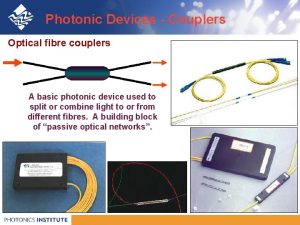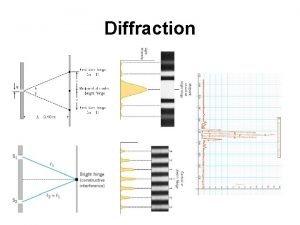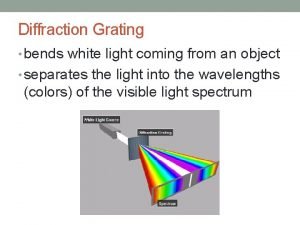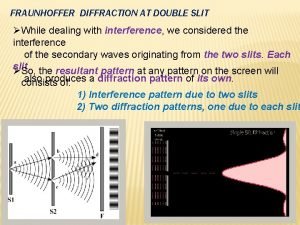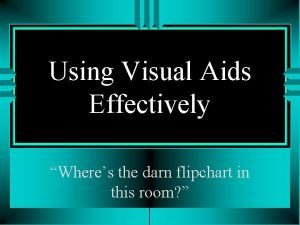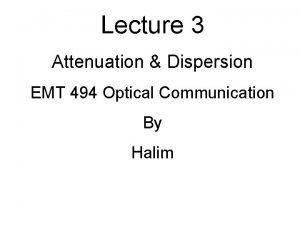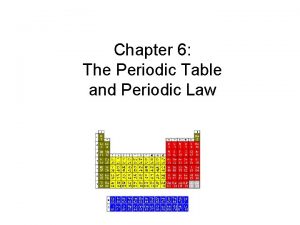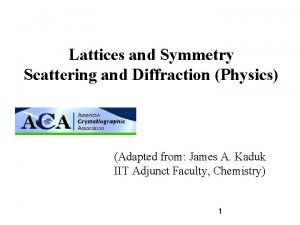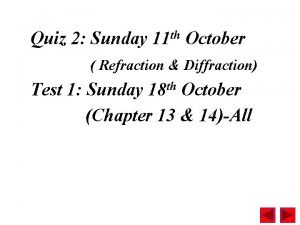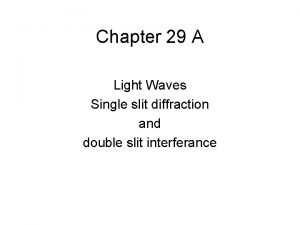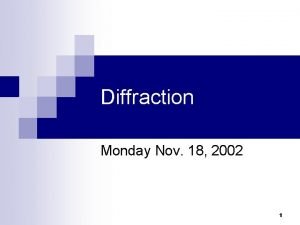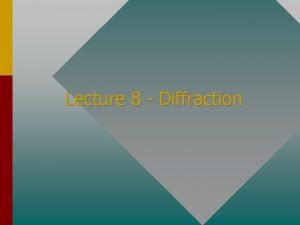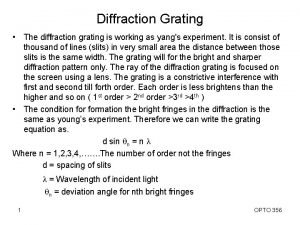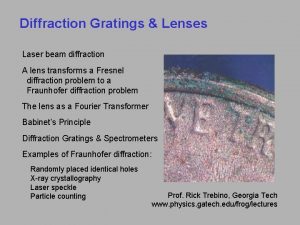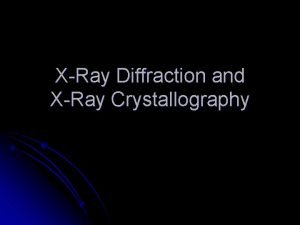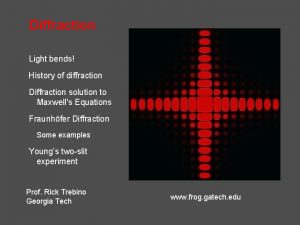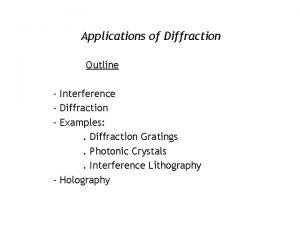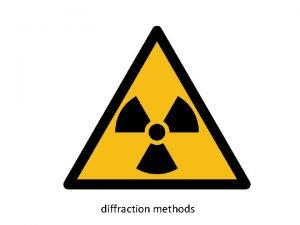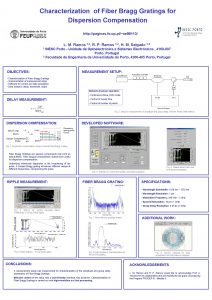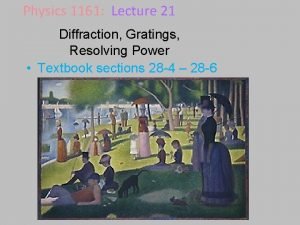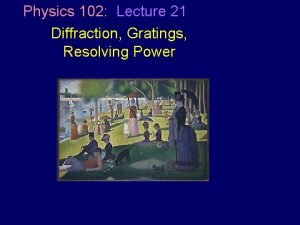Today Diffraction from periodic transparencies gratings Grating dispersion
































- Slides: 32

Today • Diffraction from periodic transparencies: gratings • Grating dispersion • Wave optics description of a lens: quadratic phase delay • Lens as Fourier transform engine 1

Diffraction from periodic array of holes incident plane wave 2 Period: Λ Spatial frequency: 1/Λ A spherical wave is generated at each hole; we need to figure out how the periodically-spaced spherical waves interfere

Diffraction from periodic array of holes Period: Λ incident plane wave Spatial frequency: 1/Λ Interference is constructive in the direction pointed by the parallel rays if the optical path difference between successive rays equals an integral multiple of λ (equivalently, the phase delay equals an integral multiple of 2π) Optical path differences 3

Diffraction from periodic array of holes Period: Λ Spatial frequency: 1/Λ From the geometry we find Therefore, interference is constructive iff 4

Diffraction from periodic array of holes incident plane wave Grating spatial frequency: 1/Λ Angular separation between diffracted orders: Δθ ≈λ/Λ 2 nd diffracted order 1 st diffracted order “straight-through” order (aka DC term) – 1 st diffracted order 5 several diffracted plane waves “diffraction orders”

Fraunhofer diffraction from periodic array of holes 6

Sinusoidal amplitude grating 7

Sinusoidal amplitude grating incident plane wave Only the 0 th and ± 1 st orders are visible 8

Sinusoidal amplitude grating one plane wave three plane waves far field +1 st order three converging spherical waves 0 th order – 1 st order diffraction efficiencies 9

Dispersion 10

Dispersion from a grating 11

Dispersion from a grating 12

Prism dispersion vs grating dispersion 13 Blue light is refracted at larger angle than red: Blue light is diffracted at smaller angle than red: normal dispersion anomalous dispersion

The ideal thin lens as a Fourier transform engine 14

Fresnel diffraction Reminder coherent plane-wave illumination The diffracted field is the convolution of the transparency with a spherical wave Q: how can we “undo” the convolution optically? 15

Fraunhofer diffraction Reminder The “far-field” (i. e. the diffraction pattern at a large longitudinal distance l equals the Fourier transform of the original transparency calculated at spatial frequencies 16 Q: is there another optical element who can perform a Fourier transformation without having to go too far (to ∞ ) ?

The thin lens (geometrical optics) f (focal length) object at ∞ (plane wave) point object at finite distance (spherical wave) 17 Ray bending is proportional to the distance from the axis

The thin lens (wave optics) incoming wavefront a(x, y) outgoing wavefront a(x, y) t(x, y)eiφ(x, y) (thin transparency approximation) 18

The thin lens transmission function 19

The thin lens transmission function this constant-phase term can be omitted where 20 is the focal length

Example: plane wave through lens plane wave: exp{i 2πu 0 x} angle θ 0, sp. freq. u 0≈ θ 0 /λ 21

Example: plane wave through lens back focal plane wavefront after lens : ignore 22 spherical wave, converging off–axis

Example: spherical wave through lens front focal plane spherical wave, diverging off–axis spherical wave (has propagated distance ) : lens transmission function : 23

Example: spherical wave through lens front focal plane spherical wave, diverging off–axis plane atwave angle wavefront after lens ignore 24

Diffraction at the back focal plane thin transparency g(x, y) 25 thin lens back focal plane diffraction pattern gf(x”, y”)

Diffraction at the back focal plane 1 D calculation Field before lens Field after lens Field at back f. p. 26

Diffraction at the back focal plane 1 D calculation 2 D version 27

Diffraction at the back focal plane spherical wave-front 28 Fourier transform of g(x, y)

Fraunhofer diffraction vis-á-vis a lens 29

Spherical – plane wave duality point source at (x, y) amplitude gin(x, y) plane wave oriented towards . . . of plane waves. . . a superposition. . . corresponding to point sources in the object 30 each output coordinate (x’, y’) receives. . .

Spherical – plane wave duality produces a spherical wave a plane wave departing produces a spherical wave converging from the transparency towards converging at angle (θx, θy) has amplitude equal to the Fourier coefficient each output coordinate at frequency (θx/λ, θy /λ) of (x’, y’) receives amplitude gin(x, y) equal to that of the corresponding Fourier component 31

Conclusions • When a thin transparency is illuminated coherently by a monochromatic plane wave and the light passes through a lens, the field at the focal plane is the Fourier transform of the transparency times a spherical wavefront • The lens produces at its focal plane the Fraunhofer diffraction pattern of the transparency • When the transparency is placed exactly one focal distance behind the lens (i. e. , z=f ), the Fourier transform relationship is exact. 32
 Optical packet switching
Optical packet switching Dispersive power of grating
Dispersive power of grating Resolving power and dispersive power of grating
Resolving power and dispersive power of grating Diffraction grating
Diffraction grating Diffraction grating
Diffraction grating Diffraction grating
Diffraction grating Missing order in diffraction
Missing order in diffraction Define transparencies
Define transparencies Transparencies visual aids
Transparencies visual aids Disadvantages of debate ppt
Disadvantages of debate ppt Material dispersion
Material dispersion Dispersed phase and dispersion medium
Dispersed phase and dispersion medium Example of colloids and its uses
Example of colloids and its uses Today's lesson or today lesson
Today's lesson or today lesson For today's meeting
For today's meeting Today's lesson or today lesson
Today's lesson or today lesson Meeting objective
Meeting objective In todays lesson
In todays lesson Fingerprint ridge characteristics worksheet
Fingerprint ridge characteristics worksheet Periodic family names
Periodic family names 6 the periodic table
6 the periodic table The periodic table and periodic law chapter 6
The periodic table and periodic law chapter 6 Chapter 5 periodic law
Chapter 5 periodic law Atomic size trend
Atomic size trend Missing order in diffraction
Missing order in diffraction First minima in diffraction
First minima in diffraction Diffraction
Diffraction How to calculate critical angle
How to calculate critical angle For viewing tiny objects in a microscope diffraction is
For viewing tiny objects in a microscope diffraction is 642008419
642008419 Fraunhofer and fresnel diffraction
Fraunhofer and fresnel diffraction Slit diffraction
Slit diffraction Diffraction
Diffraction
